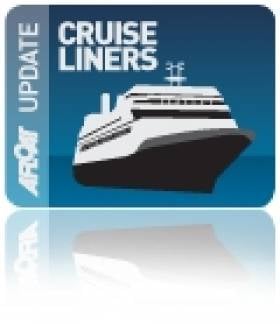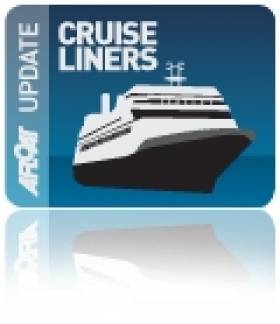Displaying items by tag: Silverseas Cruises
#CruiseLiners - Ultra-luxury expedition cruiseship, Silver Cloud anchored in Galway Bay recently as part of clockwise tour of Ireland and where today the ship is docked in Killybegs, writes Jehan Ashmore.
The call off the Port of Galway on Tuesday was the second Silverseas Cruises caller. The operator’s new flagship Silver Muse made a visit earlier this month to become the first caller this season.
A flotila of the cruiseships' zodiac tenders took guests ashore to the 'City of the Tribes'. They disembarked at the port's outer pier leading to the entrance of the Dun Aengus dock basin.
Silver Cloud is a Bahamas flagged ship that at 17,014 gross registered tonnes is deemed small today in cruiseship terms, however the Monaco based operator offers luxury at the top end of the market. They have 9 cruiseships and last year the Silver Cloud was refurbished.
According to Silversea, they provide the highest space to guest and crew to guest ratios in expedition cruising. In the case of Silver Cloud there are 257 guests served by a crew 223.
Among the facilities is an explorers’ lounge, bar, boutiques, pool deck, spa, fitness centre and a photo-studio. In addition to the Connoisseur’s Corner offering cognacs and cigars for purchase.
Accommodation consists exclusively of luxurious suites where 80% of them feature verandas.
Prior to making the anchorage call off Mutton Island in Galway Bay, Afloat monitored the ice-class 157m Silver Cloud depart Pembroke Dock, south Wales having sailed from the English Channel.
The cruiseship's first destination following the call to Milford Haven estuary was in Irish waters at the spectacular backdrop of the Skelligs, Co. Kerry. This is where the cruiseship extended its role by offering guests access to 16 zodiacs.
Other water-based equipment includes 16 kayaks opening up opportunities when cruising globally to explore through greater independence.
During the cruise leg from Galway Bay to Killybegs, Silver Cloud yesterday called off the Aran Islands at Kilronan, Inishmore. The anchorage call was followed by another off Clare Island on the approaches to Clew Bay.
The 1994 built cruiseship has since docked in the Donegal port this morning.
Cruise Liner Treesome Arrive into Foggy Dublin Bay
#CRUISE LINERS – In dense sea-fog conditions, three cruiseships arrived into Dublin Bay at dawn and proceeded to dock in Dublin Port, writes Jehan Ashmore.
Of the trio, Kristina Katarina (1982/12,668grt) today made her inaugural call to the port. As previously reported on Afloat.ie she is operated by Finnish owners Kristina Cruises based in Kotka, a city midway between Helsinki and sharing the border with the Russian Federation.
The other vessels, P&O Cruises Adonia (2001/30,277grt) and Silverseas Cruises Cloud (1994/16,927grt) are berthed within Alexandra Basin, nearby Kristina Katarina is moored on the river berth at Ocean Pier.
Reported last month another tree-some of cruiseships gathered in the port, which this year is scheduled to see around 90 such cruise callers during the season.
Silverseas Sails to Shannon Estuary
#SHANNON SILVERSEAS - The mid-west port of Foynes is playing host to the ultra-luxurious Silver Whisper (2001/28,000grt) which docked along the Shannon Estuary this morning, writes Jehan Ashmore.
The vessel operated by Silverseas Cruises had sailed from Southampton and at least another call by another vessel is also scheduled this season. On average the Shannon Foynes Port Company handles four cruise calls each season.
One of the main visitor attractions along the Shannon is the local Foynes Flying Boat Museum, which retraces an altogether different era in transportation, yet also carried out travel in style when the B314 flying boats used the Co. Limerick terminal between1937-1945. Then the trans-Atlantic travellers spent time at the Foynes hub-terminal which also became home to the 'Irish Coffee'.
On board the 382 passenger capacity vessel she has a near equal number of crew at 302. This passenger to crew ratio is exceptionally high and reflects her status in the very top end of the cruise travel market. Silverseas have over the years won a whole string of globally recognised travel industry awards.
All accommodation on board the 186m / 610ft long vessel is based in suites cabins (available in seven grades) with each featuring a balcony of ocean views and countless destinations.
Facilities include boutique shopping; a wellness spa with beauty salon, fitness centre and sauna; full-scale productions in a multi-tiered show lounge; a casino, an internet café and Wi-Fi service. To read the full range of facilities and virtual tours click HERE.
In 2012 the Silver Whisper cruising schedules are to Brazil then to South Africa and the Indian Ocean landscapes. Beyond that she heads for the South China Sea, west to the Arabian Sea and Egypt.
During the summer she explores Europe before arriving in Canada for autumn's vibrant 'fall'. Silver Whisper's globetrotting culminates in the Caribbean with cruises through the year's end.
Cruiseships Head for Cobh in advance of Queen Elizabeth
The 2,500 passenger Jewel of the Seas has a nine-deck centrum which has glass lifts which allows light to flow throughout the spacious and airy ship. Activities range from golf to climbing, a spa and sumptuous restaurants.
When the 2004 built cruiseship docks at the dedicated cruise berth at Cobh in the early hours of tomorrow she will also be sharing the deepwater berth with the 2001 built Silver Whisper. The ultra-luxury vessel accommodates only 388 passengers and is operated by SilverSeas Cruises. To read more about the vessel click HERE.
Both vessels are scheduled to depart Cobh around teatime tomorrow and this will be followed by preparations of the picturesque town which is to welcome the maiden call to Cobh of Queen Elizabeth on Saturday. To read more about the newest vessel of the Cunard Line fleet click HERE. The 2010 built vessel will firstly make an inaugural call to Dublin on Friday prior to the Cobh call which coincides with Cork Harbour Open Day, for event details visit www.corkharbour.ie
Brand New Marina Calls to Dublin
The cruise started from Copenhagen and toured several ports in Norway from where the vessel continued to Lerwick, Torshavn,Iceland, Portree and her last port of call was Belfast. The vessel had berthed in Dublin's Alexandra Basin and departed this evening bound for Dover.
Following the Marina's departure out of Dublin Bay via the North Burford bouy, was the Marco Polo. The 1965 built vessel operates for Cruise and Maritime Voyages and she proceeded past the South Burford bouy bound for St. Mary's, the capital of the Scilly Isles.
There will be many more cruisecalls such as the ultra luxury six-star Silver Cloud which is due on Sunday. The 16,927 tonnes vessel operated by Italian owned SilverSeas Cruises, has only a capacity for 294 passengers. Following that visit P&O Cruises 115,000 tonnes Azura docks in the capital this day next week to disembark up to 3,500 passengers. To view a full list of cruise callers click HERE.
Cruiseships Bound for Sunny South-East
Azamara Journey, a cruiseship built a decade ago and weighing 30,277 gross tonnes (gt) is due tomorrow (21 August) to anchor off Dunmore East. The vessel will use tender-boats to transfer passengers to the fishing port which lies on the southern approches of the Waterford estuary leading into the River Suir .
Several days after Azamara Journey's call, a further three cruise-ships will be touring the south-east. On 2 September the Crystal Symphony (51,044gt) sails overnight from Holyhead and is scheduled to take anchorage off Dunmore East and two days later a similar call is expected by the Silver Whisper. The 2001-built vessel is operated by the six-star rated Silversea Cruises.
La Diamant is due on 5 September to berth at Belview, the main port of Waterford and then is bound for the Isles of Scilly. La Diamant is owned by the only French cruise operator, Compagnie du Ponant based in Marseilles. La Diamant (8,238gt) has 172 passengers and 144 crew.
The cruise-operator specialises in offering a fleet of small bijou ships which include sail-assisted vessels. Compagnie du Ponant are a subsidiary of CMA-CGM Group, one of the world's largest container shipping companies.
Another Silversea Cruises fleetmate, Silver Cloud is due to dock on 8 September at Belview or upstream in the city-centre quays, in the heart of the newly rejuvenated 'crystal' city. Silver Cloud is on a cruise from Iceland and after the Irish call, the vessel heads for Fowey with the cruise culminating in the Pool of London.
The location of where vessels berth throughout the estuary is subject to the draft of the ship, weather conditions, tides and occupancy status of berths.

































































